ThisiscontentfromElsevier'sDrugInformation
Sacubitril; Valsartan
Learn more about Elsevier's Drug Information today! Get the drug data and decision support you need, including TRUE Daily Updates™ including every day including weekends and holidays.
General Dosing Information
24 mg sacubitril/26 mg valsartan PO twice daily, initially. Double the dose after 2 to 4 weeks to the highest dosage level tolerated. Max: 97 mg sacubitril/103 mg valsartan PO twice daily.[59904] [68064] Guidelines recommend the use of an angiotensin receptor neprilysin inhibitor (ARNI) to reduce morbidity and mortality in persons with reduced ejection fraction heart failure (HFrEF) and NYHA class II to III symptoms.[68064] An ARNI may be considered to reduce hospitalizations in select persons with preserved ejection fraction heart failure (HFpEF), particularly those with lower left ventricular ejection fractions. Sacubitril; valsartan is preferred and provides modest additional benefit compared to valsartan in persons with HFpEF.[68064] [70401]
49 mg sacubitril/51 mg valsartan PO twice daily, initially. Double the dose after 2 to 4 weeks to the highest dosage level tolerated. Max: 97 mg sacubitril/103 mg valsartan PO twice daily.[59904] [68064] Guidelines recommend the use of an angiotensin receptor neprilysin inhibitor (ARNI) to reduce morbidity and mortality in persons with reduced ejection fraction heart failure (HFrEF) and NYHA class II to III symptoms.[68064] An ARNI may be considered to reduce hospitalizations in select persons with preserved ejection fraction heart failure (HFpEF), particularly those with lower left ventricular ejection fractions. Sacubitril; valsartan is preferred and provides modest additional benefit compared to valsartan in persons with HFpEF.[68064] [70401]
24 mg sacubitril/26 mg valsartan PO twice daily, initially. Increase the dose every 2 weeks as tolerated to 49 mg sacubitril/51 mg valsartan PO twice daily, 72 mg sacubitril/78 mg valsartan PO twice daily, and then 97 mg sacubitril/103 mg valsartan PO twice daily.[59904]
0.8 mg/kg/dose PO twice daily, initially, using oral pellets or suspension. Increase the dose every 2 weeks as tolerated to 24 mg sacubitril/26 mg valsartan PO twice daily, 49 mg sacubitril/51 mg valsartan PO twice daily, and then 72 mg sacubitril/78 mg valsartan PO twice daily. Recommended mg/kg doses are of the combined amount of both sacubitril and valsartan.[59904]
15 mg sacubitril/16 mg valsartan PO twice daily, initially. Increase the dose every 2 weeks as tolerated to 30 mg sacubitril/32 mg valsartan PO twice daily, 45 mg sacubitril/48 mg valsartan PO twice daily, and then 60 mg sacubitril/64 mg valsartan PO twice daily.[59904]
12 mg sacubitril/12 mg valsartan PO twice daily, initially. Increase the dose every 2 weeks as tolerated to 24 mg sacubitril/24 mg valsartan PO twice daily, 30 mg sacubitril/32 mg valsartan PO twice daily, and then 45 mg sacubitril/48 mg valsartan PO twice daily.[59904]
9 mg sacubitril/9 mg valsartan PO twice daily, initially, using oral suspension. Increase the dose every 2 weeks as tolerated to 18 mg sacubitril/18 mg valsartan PO twice daily, 24 mg sacubitril/24 mg valsartan PO twice daily, and then 30 mg sacubitril/32 mg valsartan PO twice daily.[59904]
6 mg sacubitril/6 mg valsartan PO twice daily, initially. Increase the dose every 2 weeks as tolerated to 12 mg sacubitril/12 mg valsartan PO twice daily, 18 mg sacubitril/18 mg valsartan PO twice daily, and then 24 mg sacubitril/24 mg valsartan PO twice daily.[59904]
0.8 mg/kg/dose PO twice daily, initially. Increase the dose every 2 weeks as tolerated to 1.6 mg/kg/dose PO twice daily, 2.3 mg/kg/dose PO twice daily, and then 3.1 mg/kg/dose PO twice daily. Use oral suspension; recommended mg/kg doses are of the combined amount of both sacubitril and valsartan.[59904]
49 mg sacubitril/51 mg valsartan PO twice daily, initially. Increase the dose every 2 weeks as tolerated to 72 mg sacubitril/78 mg valsartan PO twice daily and then 97 mg sacubitril/103 mg valsartan PO twice daily.[59904]
24 mg sacubitril/26 mg valsartan PO twice daily, initially. Increase the dose every 2 weeks as tolerated to 49 mg sacubitril/51 mg valsartan PO twice daily and then 72 mg sacubitril/78 mg valsartan PO twice daily.[59904]
30 mg sacubitril/32 mg valsartan PO twice daily, initially. Increase the dose every 2 weeks as tolerated to 45 mg sacubitril/48 mg valsartan PO twice daily and then 60 mg sacubitril/64 mg valsartan PO twice daily.[59904]
24 mg sacubitril/24 mg valsartan PO twice daily, initially. Increase the dose every 2 weeks as tolerated to 30 mg sacubitril/32 mg valsartan PO twice daily and then 45 mg sacubitril/48 mg valsartan PO twice daily.[59904]
18 mg sacubitril/18 mg valsartan PO twice daily, initially. Increase the dose every 2 weeks as tolerated to 24 mg sacubitril/24 mg valsartan PO twice daily and then 30 mg sacubitril/32 mg valsartan PO twice daily.[59904]
12 mg sacubitril/12 mg valsartan PO twice daily, initially. Increase the dose every 2 weeks as tolerated to 18 mg sacubitril/18 mg valsartan PO twice daily and then 24 mg sacubitril/24 mg valsartan PO twice daily.[59904]
1.6 mg/kg/dose PO twice daily, initially. Increase the dose every 2 weeks as tolerated to 2.3 mg/kg/dose PO twice daily and then 3.1 mg/kg/dose PO twice daily. Use oral suspension; recommended mg/kg doses are of the combined amount of both sacubitril and valsartan.[59904]
sacubitril 194 mg/day PO; valsartan 206 mg/day PO for oral tablets; safety and efficacy have not been established for oral pellets.
sacubitril 194 mg/day PO; valsartan 206 mg/day PO for oral tablets; safety and efficacy have not been established for oral pellets.
weighing 50 kg or more: sacubitril 194 mg/day PO; valsartan 206 mg/day PO for oral tablets; safety and efficacy have not been established for oral pellets.
weighing 40 to 49 kg: sacubitril 144 mg/day PO; valsartan 156 mg/day PO for oral tablets; sacubitril 120 mg/day PO; valsartan 128 mg/day PO for oral pellets.
weighing 34 to 39 kg: sacubitril 120 mg/day PO; valsartan 128 mg/day PO for oral pellets.
weighing 26 to 33 kg: sacubitril 90 mg/day PO; valsartan 96 mg/day PO for oral pellets.
weighing 50 kg or more: sacubitril 194 mg/day PO; valsartan 206 mg/day PO for oral tablets; safety and efficacy have not been established for oral pellets.
weighing 40 to 49 kg: sacubitril 144 mg/day PO; valsartan 156 mg/day PO for oral tablets; sacubitril 120 mg/day PO; valsartan 128 mg/day PO for oral pellets.
weighing 34 to 39 kg: sacubitril 120 mg/day PO; valsartan 128 mg/day PO for oral pellets.
weighing 26 to 33 kg: sacubitril 90 mg/day PO; valsartan 96 mg/day PO for oral pellets.
weighing 19 to 25 kg: sacubitril 60 mg/day PO; valsartan 64 mg/day PO for oral pellets.
weighing 13 to 18 kg: sacubitril 48 mg/day PO; valsartan 48 mg/day PO for oral pellets.
weighing less than 13 kg: 6.2 mg/kg/day PO (combined amount of sacubitril and valsartan) for oral suspension.
Safety and efficacy have not been established.
Safety and efficacy have not been established.
Mild hepatic impairment: No dosage adjustment needed.
Moderate hepatic impairment (Child-Pugh Class B): Initiate at half the usual recommended dose; thereafter, follow the recommended dose escalation. In pediatric patients weighing 40 to 50 kg, initiate at 0.8 mg/kg/dose (combined amount of sacubitril and valsartan) PO twice daily using oral suspension or oral pellets.
Severe hepatic impairment: Use not recommended.[59904]
eGFR 30 mL/minute/1.73 m2 or more: No dosage adjustment needed.
eGFR less than 30 mL/minute/1.73 m2: Initiate at half the usual recommended dose; thereafter, follow the recommended dose escalation. In pediatric patients weighing 40 to 50 kg, initiate at 0.8 mg/kg/dose (combined amount of sacubitril and valsartan) PO twice daily using oral suspension or oral pellets.[59904]
Hemodialysis
Sacubitril; valsartan is unlikely to be removed by hemodialysis due to high protein binding.[59904]
† Off-label indication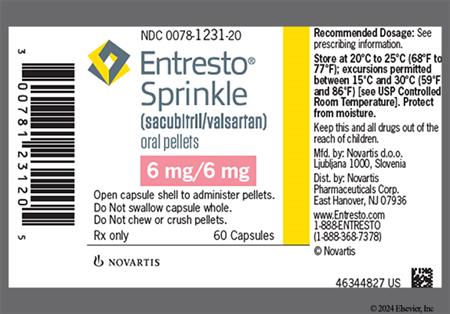

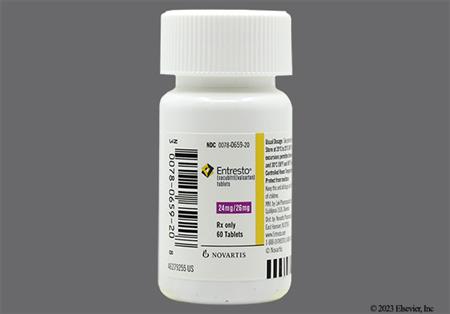
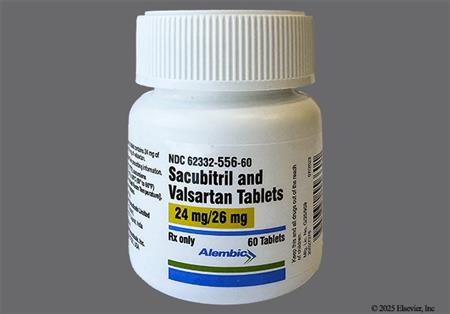

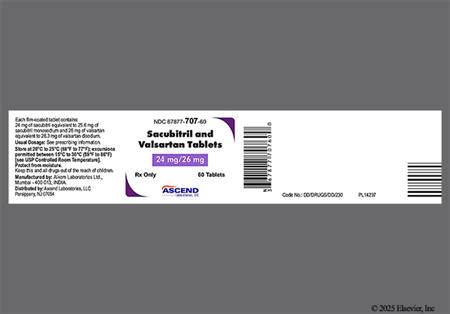
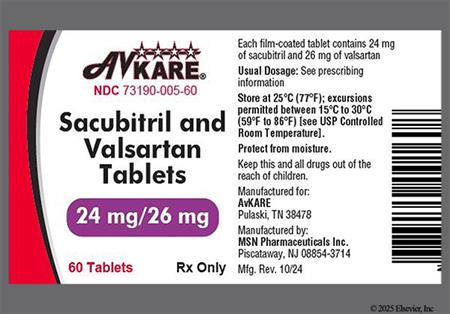
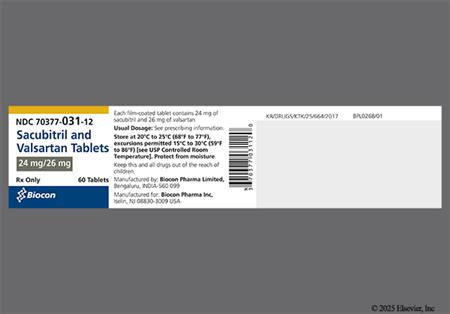
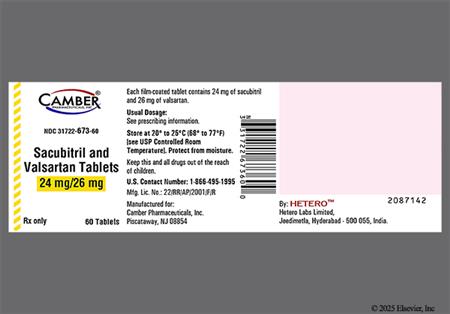
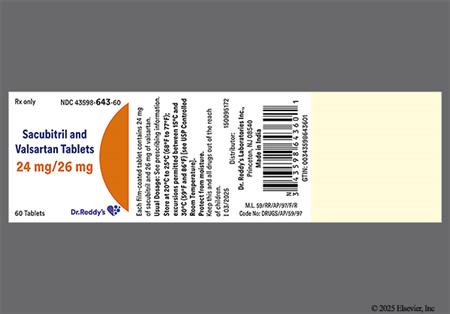
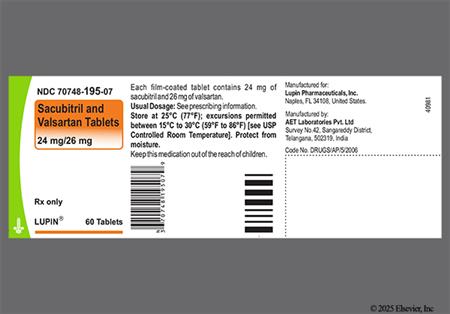
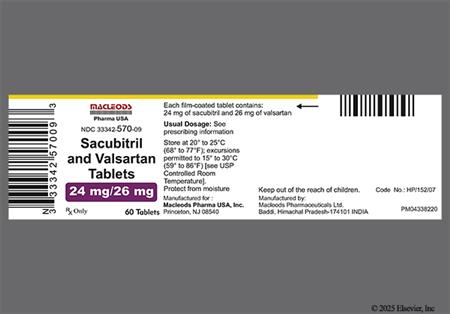
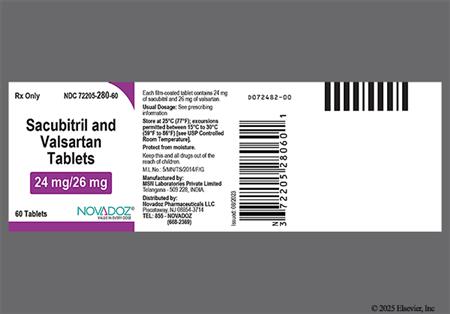
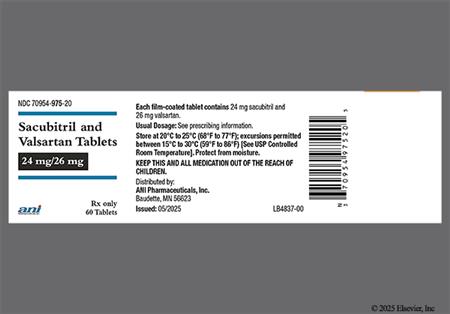
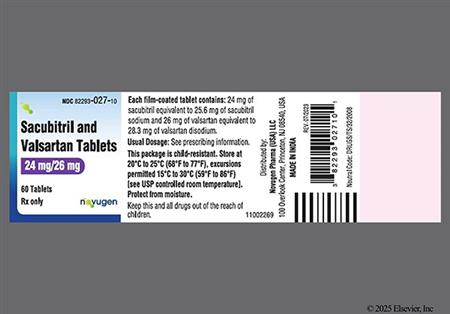
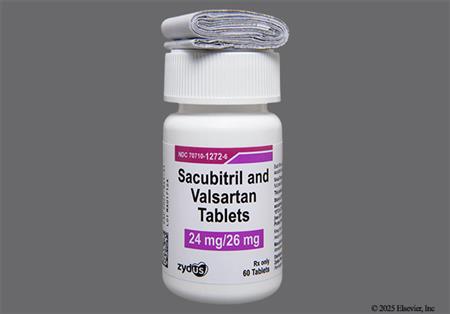
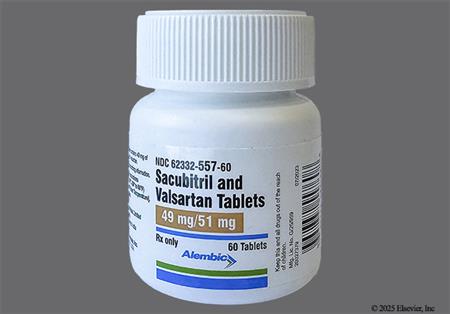
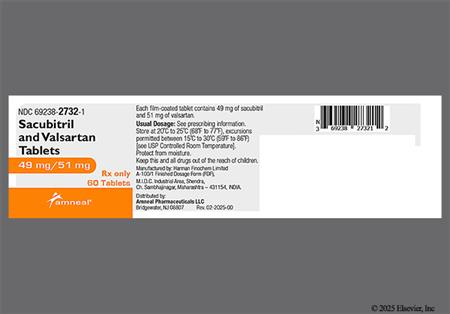
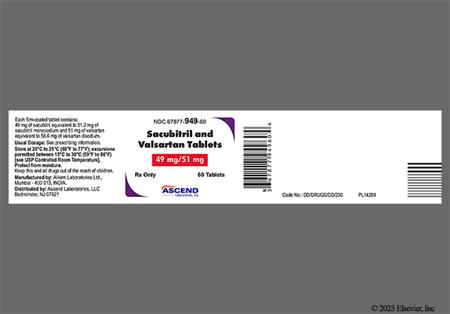
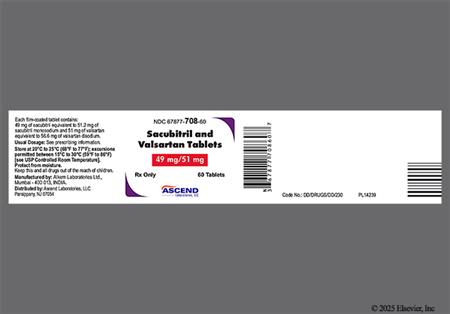
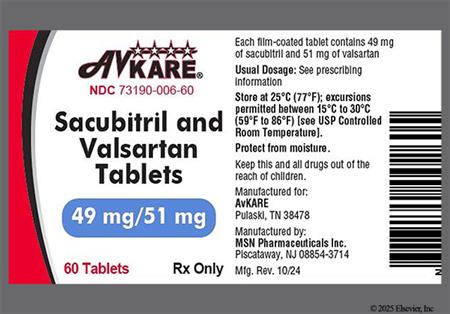
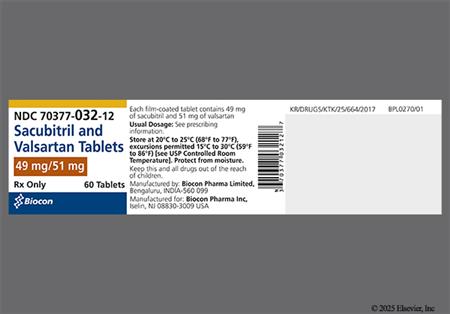
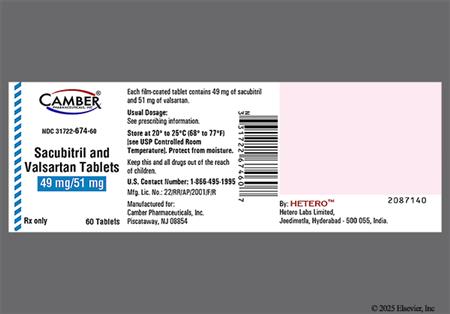
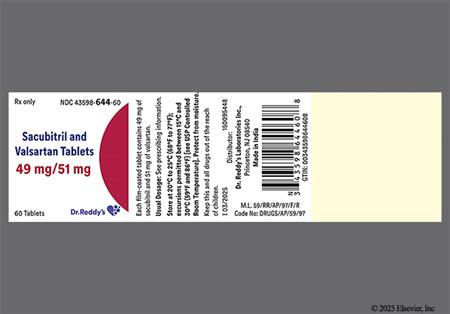
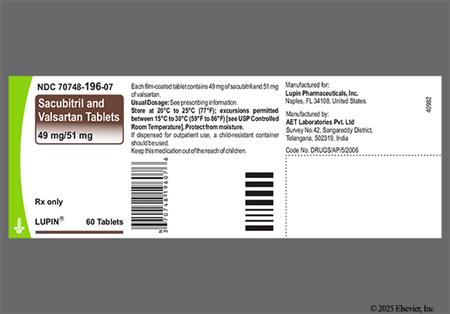
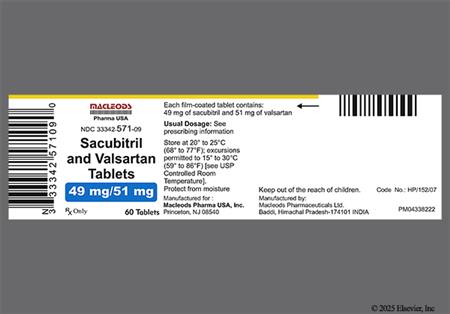
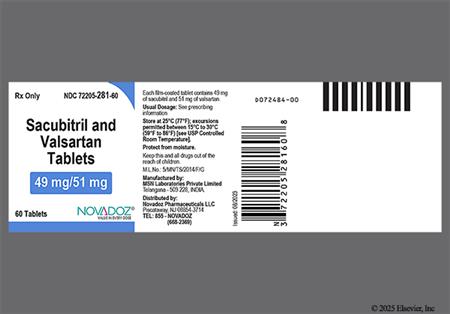
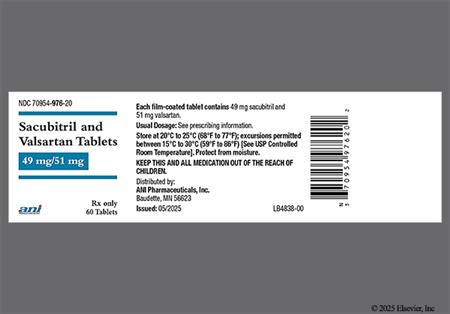
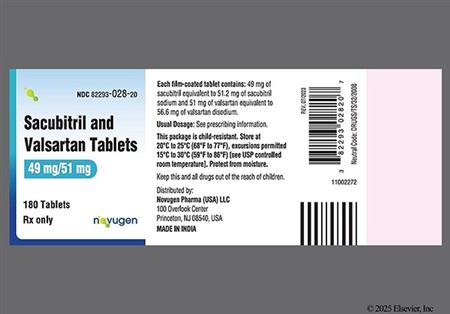
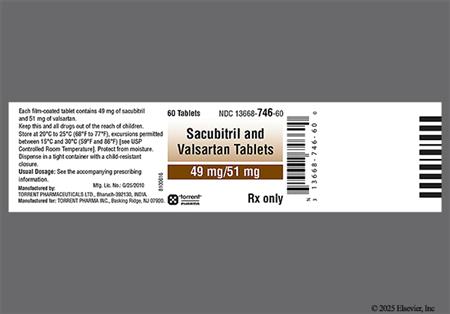
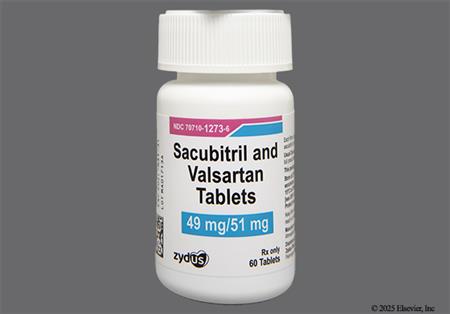
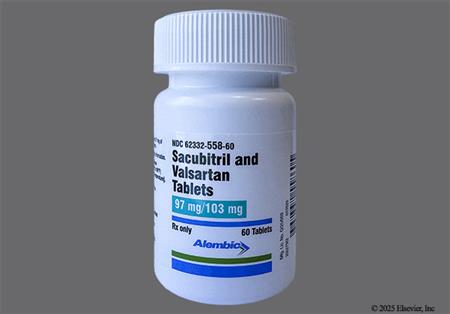
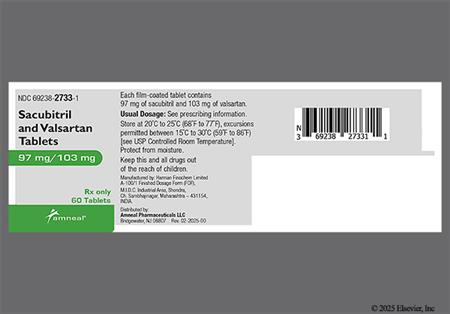
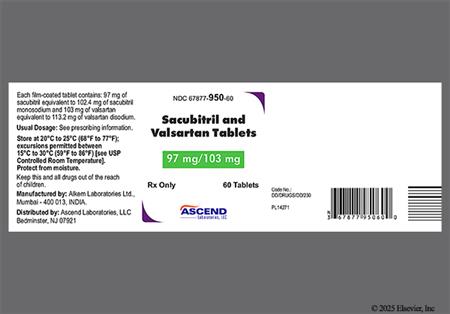
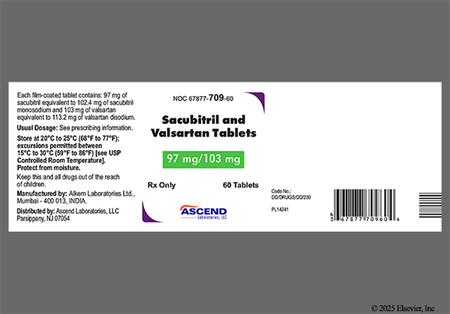
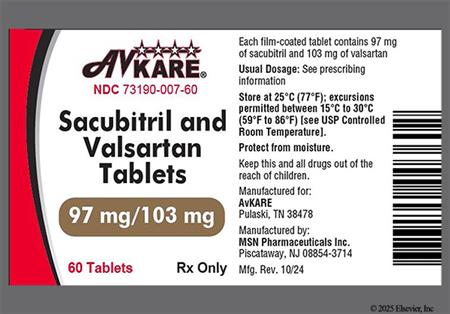
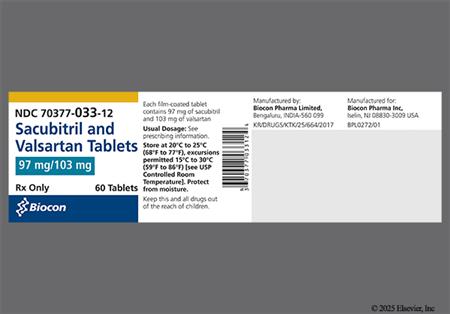
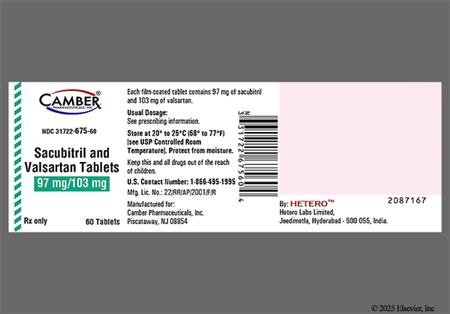
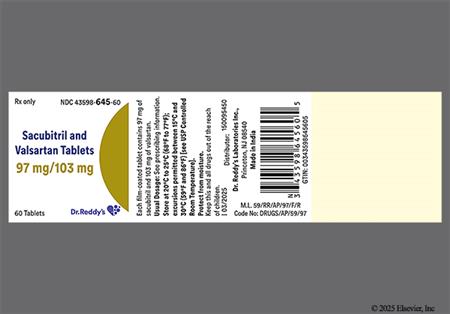
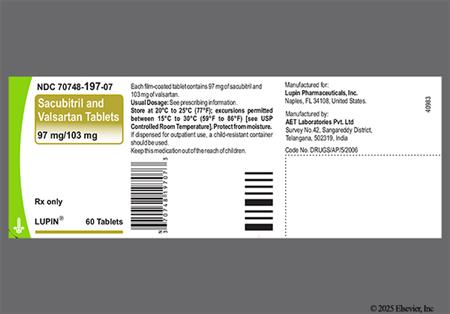
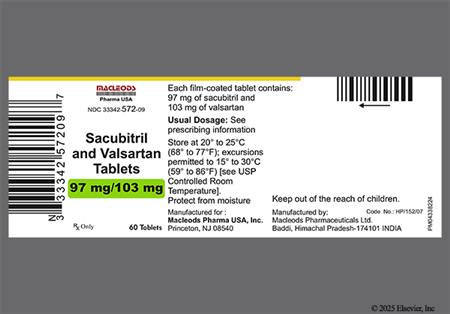
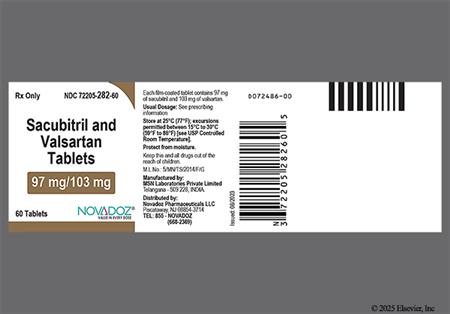
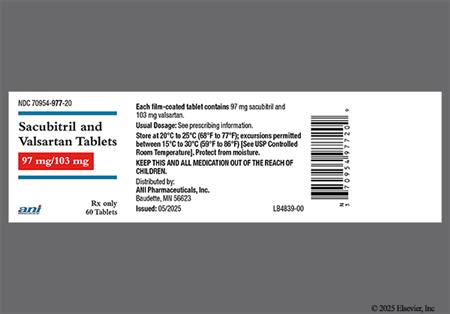
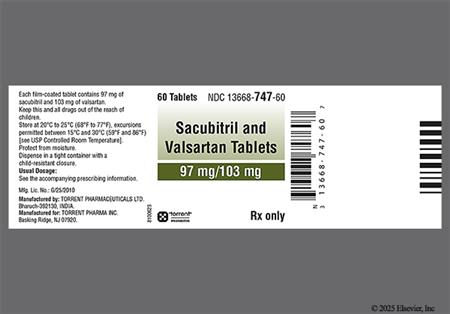
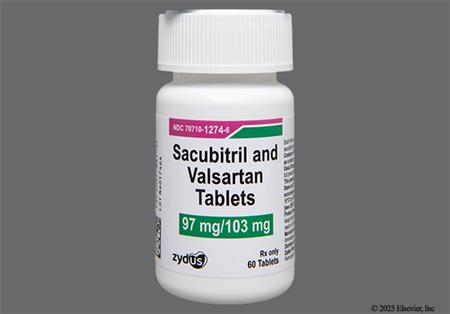
Sacubitril; valsartan is a combination product containing sacubitril, a neprilysin inhibitor, and valsartan, an angiotensin II receptor blocker. Sacubitril; valsartan is indicated in adults to reduce the risk of cardiovascular death and hospitalization for heart failure in patients with chronic heart failure. The benefits of sacubitril; valsartan therapy in adult patients with chronic heart failure are most evident in those patients with left ventricular ejection fraction (LVEF) below normal. In the PARADIGM-HF trial, sacubitril; valsartan was superior to enalapril in reducing the rate of cardiovascular death and hospitalizations related to heart failure in adults with symptomatic chronic heart failure (NYHA class II to IV) and systolic dysfunction (LVEF of 40% or less). Most patients were also receiving standard heart failure treatments including beta-blockers, diuretics, and mineralocorticoid antagonists.[59939] In the PARAGON-HF trials, the rate of the primary composite outcome (first and recurrent heart failure hospitalizations and cardiovascular death) was lower in the sacubitril; valsartan group at 12.8 events per 100 patient years compared to the valsartan group at 14.6 events per 100 patient years (RR = 0.87 (0.75, 1.01), p = 0.06). The PARAGON-HF trial enrolled adult patients with symptomatic heart failure with LVEF of 45% or higher and structural heart disease (either left atrial enlargement or left ventricular hypertrophy). Most patients were also receiving a beta-blockers and diuretics.[66422] In an analysis of both the PARADIGM-HF and PARAGON-HF studies, greater risk reductions were observed with patients with LVEF below normal treated with sacubitril; valsartan.[59904] In pediatric patients 1 year and older, sacubitril; valsartan is indicated for the treatment of symptomatic heart failure with systemic left ventricular systolic dysfunction. Results from PANORAMA-HF trial showed a reduction from baseline in NT-proBNP of 44% in sacubitril; valsartan-treated patients compared to 33% in enalapril-treated patients. While not statistically significant, the reductions were similar or larger than what were seen in adult patients. This effect on NT-proBNP was considered a reasonable basis to infer improved cardiovascular outcomes in the pediatric populations, as similar outcomes were seen in the PARADIGM-HF study. Sacubitril; valsartan is contraindicated with concomitant use of an ACE inhibitor; allow a 36-hour washout period between administration of the 2 drugs. The most common adverse effects reported include hypotension, hyperkalemia, cough, dizziness, and renal failure.[59904]
For storage information, see the specific product information within the How Supplied section.
Oral Pellets
Tablets
Preparation of 4 mg/mL (1.96 mg sacubitril; 2.04 mg valsartan/mL) oral suspension
Angioedema has been reported with the use of sacubitril; valsartan. During clinical trials, angioedema was reported in 0.5% of patients treated with sacubitril; valsartan compared to 0.2% of those treated with enalapril. The incidence of angioedema was higher in Black patients (2.4%) receiving sacubitril; valsartan compared to non-Black patients (0.4%).[69374] If angioedema occurs, immediately discontinue sacubitril; valsartan therapy, provide appropriate therapy, and monitor for airway compromise. Do not readminister sacubitril; valsartan to patients who have experienced angioedema with its use. In cases where swelling was confined to the face and lips, the condition generally resolved without treatment; however, antihistamines have been used for symptom relief. Laryngeal edema may be fatal. If there is involvement of the tongue, glottis, or larynx, administer appropriate therapy (e.g., epinephrine) to ensure airway patency. Anaphylactoid reactions, pruritus, and rash have been reported during postmarketing use of sacubitril; valsartan.[59904]
Drugs which affect the renin-angiotensin system have been associated with fetal and neonatal abnormalities when administered to pregnant patients. Adverse fetal and neonatal effects have included hypotension, neonatal skull hypoplasia, anuria, reversible or irreversible renal failure, oligohydramnios, and death. Oligohydramnios has been associated with fetal limb contractures, craniofacial deformation, and hypoplastic lung development. Due to the potential for teratogenesis, every effort should be made to discontinue sacubitril; valsartan and consider alternative therapy during pregnancy.[59904]
Hypotension has been reported with the use of sacubitril; valsartan. During controlled clinical trials, hypotension was reported in 18% of patients treated with sacubitril; valsartan and in 12% of those receiving enalapril. Hypotension was reported as serious in 1.5% of patients in both treatment arms. Orthostatic hypotension was reported in 2.1% of patients receiving sacubitril; valsartan and 1.1% of patients in the enalapril group. Falls were reported in 1.9% of those receiving sacubitril; valsartan compared to 1.3% of those receiving enalapril. Dizziness was reported in 6% of patients in the sacubitril; valsartan group and 5% in the enalapril group. Volume and salt depletion should be corrected prior to initiating therapy. If hypotension is anticipated, initiating therapy at a lower dose may be necessary. If hypotension occurs during therapy, ensure hypovolemia has not occurred and consider dose adjustments of diuretics and other concomitant antihypertensive drugs. If hypotension persists despite such measures, reduce the dosage or temporarily discontinue sacubitril; valsartan; permanent discontinuation of therapy is usually not required.[59904]
Decrease in renal function has been reported with the use of sacubitril; valsartan. During the PARADIGM-HF clinical trial, renal failure (unspecified) was reported in 5% of patients in both the sacubitril; valsartan and enalapril groups. Increases in serum creatinine of more than 50% were observed in 1.4% of patients in the enalapril run-in period and 2.2% of patients in the sacubitril; valsartan run-in period. During the double-blind period, increases in serum creatinine of more than 50% were reported in approximately 16% of both treatment groups. In the PARAGON-HF trial, increases in serum creatinine of more than 50% were reported in approximately 17% of sacubitril; valsartan patients and 21% of valsartan patients. Oliguria, progressive azotemia, and, rarely, acute renal failure and death have been associated in patients receiving angiotensin-converting enzyme (ACE) inhibitors and angiotensin II receptor blockers (ARBs) whose renal function depends upon the activity of the renin-angiotensin-aldosterone system (e.g., patients with severe congestive heart failure). If a clinically significant decrease in renal function develops, closely monitor serum creatinine and decrease the dose or interrupt sacubitril; valsartan therapy. In addition, serum creatinine and blood urea concentrations may increase in patients with bilateral or unilateral renal artery stenosis.[59904]
Hyperkalemia was reported in 12% of patients treated with sacubitril; valsartan and 14% of patients treated with enalapril during controlled trials. Potassium concentrations more than 5.5 mEq/L were reported in approximately 4% of patients in both the enalapril and sacubitril; valsartan run-in periods. During the double-blind period in the PARADIGM-HF trial, approximately 16% of both treatment groups reported potassium concentrations more than 5.5 mEq/L. During the double-blind period in the PARAGON-HF trial, approximately 18% of sacubitril; valsartan patients and 20% of valsartan patients reported potassium concentrations more than 5.5 mEq/L. Monitor serum potassium periodically and treat appropriately. Dosage reduction or interruption of therapy may be required.[59904]
During controlled clinical trials, cough was reported in 9% of patients receiving sacubitril; valsartan compared to 13% of those in the enalapril group.[59904]
Rhabdomyolysis has been reported with the postmarketing use of sacubitril; valsartan. During clinical trials, evidence of possible muscle harm was noted.[63529]
The coadministration of certain medications may lead to harm and require avoidance or therapy modification; review all drug interactions prior to concomitant use of other medications.
This medication is contraindicated in patients with a history of hypersensitivity to it or any of its components.
Sacubitril; valsartan is contraindicated in individuals with a history of ACE inhibitor induced angioedema or ARB induced angioedema. Sacubitril; valsartan should not be used in individuals with hereditary angioedema. Angioedema was reported during clinical trials of sacubitril; valsartan. Black patients and individuals with a prior history of angioedema may be at increased risk of angioedema with sacubitril; valsartan.[59904]
In individuals with an activated renin-angiotensin system, such as individuals with hypovolemia or hyponatremia receiving high doses of diuretics, symptomatic hypotension may occur with valsartan. Correct volume or salt depletion prior to sacubitril; valsartan administration, or initiate treatment at a lower dose.[59904]
Angiotensin II receptor blockers (ARBs) can cause hyperkalemia. Risk factors for the development of hyperkalemia include renal insufficiency, diabetes mellitus, hypoaldosteronism, high potassium diet, and concomitant use of potassium-sparing diuretics, potassium supplements, and/or potassium-containing salt substitutes. Individuals whose renal function may depend on the activity of the renin-angiotensin system (e.g., individuals with renal artery stenosis, chronic renal disease, severe heart failure, or hypovolemia) may be at risk for developing acute renal failure on ARB therapy. Consider withholding or discontinuing sacubitril; valsartan in individuals who develop a clinically significant decrease in renal function while receiving therapy. Monitor renal function and potassium periodically in individuals receiving sacubitril; valsartan therapy. Reduce the initial dose of sacubitril; valsartan in individuals with severe renal impairment (glomerular filtration rate less than 30 mL/minute/1.73 m2).[29130] [38969] [59904] Dialysis is also a risk factor for symptomatic hypotension with ARBs.[27991]
Sacubitril; valsartan is contraindicated for use in individuals with diabetes when coadministered with certain medications, specifically aliskiren.[59904]
Once pregnancy is detected, discontinue sacubitril; valsartan as soon as possible. Use of medications that affect the renin-angiotensin system (RAS), such as ACE inhibitors and angiotensin II receptor antagonists, are generally not recommended for use during pregnancy. Use of RAS inhibitors during the second and third trimesters of pregnancy is associated with reduced fetal renal function and increased risks of fetal and neonatal morbidity and mortality. Exposure to these agents in pregnancy may result in adverse outcomes including fetal death, hypotension, neonatal skull hypoplasia, craniofacial abnormalities, fetal limb contractures, hypoplastic lung development, anuria, fetal growth restriction, and both reversible and irreversible renal failure. Additionally, cases of oligohydramnios and anhydramnios have been reported. Development of oligohydramnios may be associated with fetal lung hypoplasia and skeletal deformations.[59904] [63903] [65551] [68837] [68860] Use of RAS inhibitors during the first trimester of pregnancy may increase the risk of fetal harm, such as congenital malformations; however, available data are conflicting.[32294] [46406] [64367] [71327] [71329] In rare cases when another antihypertensive agent cannot be used to treat a pregnant patient, serial ultrasound examinations should be performed to assess the intra-amniotic environment. If oligohydramnios is observed, discontinue sacubitril; valsartan unless it is considered life-saving for the pregnant individual. Oligohydramnios may not appear until after the fetus has sustained irreversible injury.[59904]
Administration of sacubitril; valsartan is not recommended in individuals with severe hepatic disease or hepatic failure (Child-Pugh class C), as no studies have been conducted in these individuals. Dose adjustments are recommended in individuals with moderate hepatic impairment (Child-Pugh class B); no dose adjustment is required when administering sacubitril; valsartan to individuals with mild hepatic impairment (Child-Pugh class A).[59904]
Counsel people who may become pregnant about the reproductive risk and embryo-fetal toxicity associated with medications that affect the renin-angiotensin system (RAS), such as ACE inhibitors and angiotensin II receptor antagonists. Use of RAS inhibitors during the second and third trimesters of pregnancy is associated with reduced fetal renal function and increased risks of fetal and neonatal morbidity and mortality.[59904] [63903] [65551] [68837] [68860]
Closely observe neonates and infants exposed to this medication in utero for hypotension, oliguria, and hyperkalemia. If oliguria or hypotension occurs, blood pressure and renal perfusion support may be required, as well as exchange transfusion or dialysis to reverse hypotension and/or support decreased renal function.[59904]
Use sacubitril; valsartan with caution in breast-feeding patients. There are no data on the presence of sacubitril; valsartan in human milk, its effects on the breastfed child, or its effects on milk production.[59904] Alternative therapies may be considered. Due to low concentrations in breast milk, guidelines generally consider the ACE inhibitors captopril and enalapril to be compatible with breast-feeding unless high doses are required.[63903] [68837] In addition, benazepril and quinapril are excreted in low quantities into breast milk and have been suggested as options during breast-feeding.[65551] [68835] [68836] If a patient is switched from sacubitril; valsartan to an ACE inhibitor, allow a 36-hour washout period prior to starting the ACE inhibitor.[59904]
Due to renin-angiotensin system blockade, individuals treated with angiotensin II receptor blockers and undergoing major surgery and anesthesia may experience hypotension, which is very rarely severe, such that it may require the use of intravenous fluids and vasopressors.[27991]
Sacubitril is a neprilysin inhibitor, and valsartan antagonizes angiotensin II at the AT1 receptor subtype. Neprilysin degrades endogenous vasoactive peptides, including natriuretic peptide, bradykinin, and adrenomedullin. Inhibition of neprilysin results in increased concentrations of these proteins and their activities, resulting in vasodilation, natriuresis, diuresis, and inhibition of pathologic growth and fibrosis. Inhibition of neprilysin occurs via the active metabolite of sacubitril, LBQ657. Angiotensin II is a potent vasoconstrictor and also stimulates the production and release of aldosterone.[59939][59940] The cardiovascular and renal effects of sacubitril; valsartan in patients with heart failure are due to increased concentrations of peptides that are degraded by neprilysin and the simultaneous inhibition of angiotensin II and angiotensin II-dependent aldosterone release by valsartan.[59904]
Revision Date: 10/07/2025, 09:41:05 AMSacubitril; valsartan is administered orally. Sacubitril and valsartan are highly bound to plasma proteins (more than 94%). Sacubitril is converted to its active metabolite, LBQ657, by plasma esterases and not further metabolized. Valsartan is minimally metabolized; approximately 20% of the dose is recovered as metabolites. A hydroxyl metabolite has been identified at low concentrations (less than 10%) in plasma. LBQ657 crosses the blood brain barrier to a minimal extent (0.28%). The average volume of distribution of sacubitril and valsartan is 103 and 75 L, respectively. After oral administration, 52% to 68% of sacubitril (primarily as metabolite) and approximately 13% of valsartan and its metabolites are excreted in urine. The remaining drug and metabolites are excreted in feces. Sacubitril, LBQ657, and valsartan exhibit a mean elimination half-life of approximately 1.4, 11.5, and 9.9 hours, respectively.[59904]
In a 21-day study of patients with heart failure and reduced ejection fraction, sacubitril; valsartan administration resulted in significantly increased urine atrial natriuretic peptide (ANP) and cyclic guanosine monophosphate (cGMP) and plasma cGMP, and decreased plasma N-terminal pro b-type natriuretic peptide (NT-proBNP), aldosterone, and endothelin-1. Sacubitril; valsartan blocked the AT1-receptor resulting in increased plasma renin activity and plasma renin concentrations. In PARADIGM-HF, sacubitril; valsartan decreased NT-proBNP, increased BNP, and increased urine cGMP compared to enalapril. In the PARAMOUNT study that enrolled patients with heart failure with left ventricular ejection fraction (LVEF) of 45% or higher, sacubitril; valsartan (97 mg; 103 mg twice daily) decreased NT-proBNP by 17% compared to an 8% decrease with valsartan (160 mg twice daily) after 12 weeks of therapy. In the PARAGON-HF study, NT-proBNP was decreased by 24% at week 16 and 19% at week 48 in the sacubitril; valsartan group compared to 6% and 3%, respectively, in the valsartan group.[59904]
Affected cytochrome P450 isoenzymes and drug transporters: CYP2C9, OATP1B1, OATP1B3, MRP2
Valsartan does not inhibit CYP450 isoenzymes at clinically relevant concentrations. In vitro studies indicate CYP2C9 is the isoenzyme responsible for the formation of valeryl-4-hydroxy valsartan. An in vitro study with human liver tissue indicates that it is a substrate of the hepatic uptake transporter OATP1B1 and the hepatic efflux transporter MRP2.[29130][62719] In vitro data also indicate that sacubitril inhibits OATP1B1 and OSTP1B3 transporters.[59904]
After oral administration, the peak plasma concentrations of sacubitril, its metabolite, and valsartan are reached in 0.5, 2, and 1.5 hours, respectively. Oral absolute bioavailability of sacubitril is estimated to be 60% or more. Valsartan when combined in the sacubitril; valsartan combination product is more bioavailable than valsartan in other marketed tablet formulations; 26 mg, 51 mg, and 103 mg of valsartan in sacubitril; valsartan is equivalent to 40 mg, 80 mg, and 160 mg of valsartan in other marketed formulations. Steady state concentrations of sacubitril, its metabolite, and valsartan are reached in 3 days. At steady state, sacubitril and valsartan do not accumulate; however, the metabolite of sacubitril accumulates by 1.6-fold. Food has no clinically significant effect on the systemic exposure of sacubitril; valsartan.[59904]
The exposure to sacubitril; valsartan is similar in pediatric and adult patients.[59904]
No relevant pharmacokinetic differences have been observed for sacubitril; valsartan in patients 65 years and older compared to the overall population.[59904]
Gender does not have a clinically significant effect on the systemic exposure of sacubitril or valsartan.[59904]
Once pregnancy is detected, discontinue sacubitril; valsartan as soon as possible. Use of medications that affect the renin-angiotensin system (RAS), such as ACE inhibitors and angiotensin II receptor antagonists, are generally not recommended for use during pregnancy. Use of RAS inhibitors during the second and third trimesters of pregnancy is associated with reduced fetal renal function and increased risks of fetal and neonatal morbidity and mortality. Exposure to these agents in pregnancy may result in adverse outcomes including fetal death, hypotension, neonatal skull hypoplasia, craniofacial abnormalities, fetal limb contractures, hypoplastic lung development, anuria, fetal growth restriction, and both reversible and irreversible renal failure. Additionally, cases of oligohydramnios and anhydramnios have been reported. Development of oligohydramnios may be associated with fetal lung hypoplasia and skeletal deformations.[59904] [63903] [65551] [68837] [68860] Use of RAS inhibitors during the first trimester of pregnancy may increase the risk of fetal harm, such as congenital malformations; however, available data are conflicting.[32294] [46406] [64367] [71327] [71329] In rare cases when another antihypertensive agent cannot be used to treat a pregnant patient, serial ultrasound examinations should be performed to assess the intra-amniotic environment. If oligohydramnios is observed, discontinue sacubitril; valsartan unless it is considered life-saving for the pregnant individual. Oligohydramnios may not appear until after the fetus has sustained irreversible injury.[59904]
Use sacubitril; valsartan with caution in breast-feeding patients. There are no data on the presence of sacubitril; valsartan in human milk, its effects on the breastfed child, or its effects on milk production.[59904] Alternative therapies may be considered. Due to low concentrations in breast milk, guidelines generally consider the ACE inhibitors captopril and enalapril to be compatible with breast-feeding unless high doses are required.[63903] [68837] In addition, benazepril and quinapril are excreted in low quantities into breast milk and have been suggested as options during breast-feeding.[65551] [68835] [68836] If a patient is switched from sacubitril; valsartan to an ACE inhibitor, allow a 36-hour washout period prior to starting the ACE inhibitor.[59904]
Cookies are used by this site. To decline or learn more, visit our cookie notice.
Copyright © 2025 Elsevier, its licensors, and contributors. All rights are reserved, including those for text and data mining, AI training, and similar technologies.